Musicarta Modes - Mediant Substitution
Mediant Substitution (Part 3)
This Module applies the mediant substitution technique to the i-ëVII-ëVI chord sequence from Module Six (One minor, Flat Seven and Flat Six).
Download up-to-date MIDI files for this page.
In A Aeolian minor, these chords are A minor (i), G (ëVII) and F (ëVI) – three all-white-key chords. Run through the three sets of inversions of the three chords.
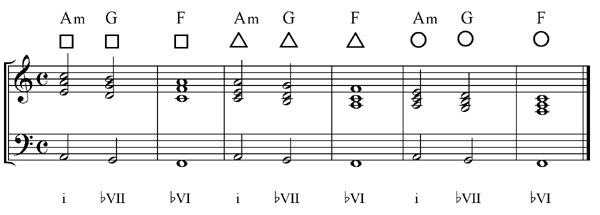
Making a practice piece
You can make practising the inversions sound more musical by using the G chord from the next set of inversions to transition between positions (circled in the following MS example), and finishing it off neatly.
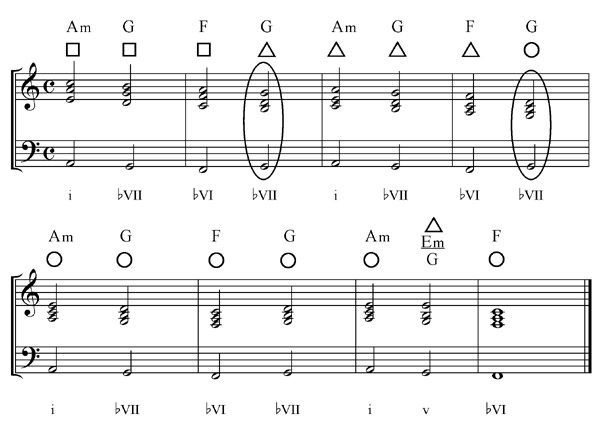
Practising cycling through the three sets of inversions in a chord sequence like this will put chords under your fingertips faster than anything else..
Add a beat and a broken chord pattern, and you’re
learning something usable as you practice. Here is the BMT (bottom, middle, top)
pattern used for the first six bars.
(The colon : indicates that the bar is split equally between the two chords.)
The second time the chord sequence is played, the first note of the second (and fourth and sixth) bar is dragged forward (anticipated). Listen carefully to the audio clip until you can hear it, and imitate it – once you can play the ‘straight’ version.
Creating a mediant substitution riff
Mediant substitution is a way of making your chords sound richer by lowering the root of the existing three-note chords (triads) to create new seventh chords.
If we shift the bass line of the last music sample down a third (except for the last two chords), we get this.
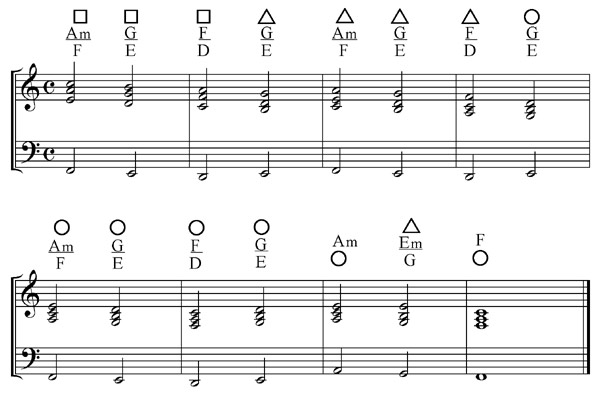
This audio demonstration of mediant substitution plays through the substituted seventh chords twice, then adds broken chord and rhythmic variation to turn the exercise into a usable riff.
Here is the written out music for the riff performance.
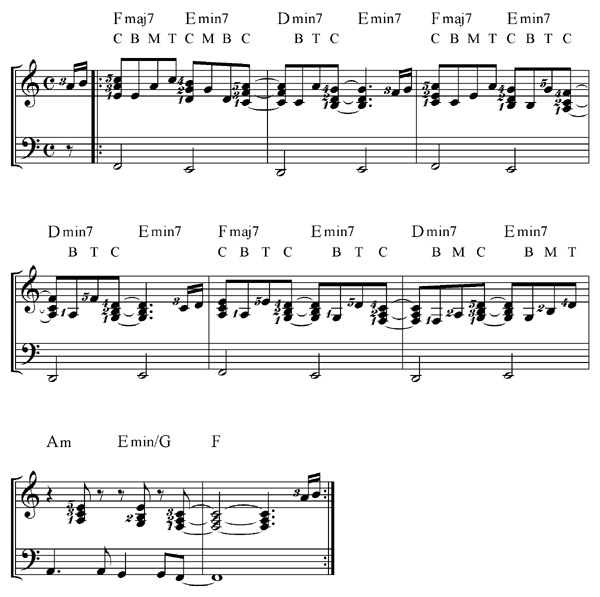
The BMT analysis (bottom, middle, top, plus C for chord) refers the ‘looks like’ triads played as the upper part of the seventh chords. refer to the keyboards diagrams earlier if necessary to remind yourself what these are.
Students of solo keyboard style will find close study of the fingering given here rewarding. There are very few alternatives if you want to play both chords and melody in your right hand – as a solo performer must. Use solo pieces like this as exercises to make your hand learn the necessary skills and conform to the requirements of the style.
Mixed original and mediant substitution chords
The audio riff above uses all the possible mediant substitution seventh chords. The ear can find this overwhelming. Here are some riffs which mix original chords and mediant substitution seventh chords.
Mixed Riff 1

The right hand still plays only A minor, G and F triads. The bass (left hand) is either dropped a third to create mediant substitution seventh chords or not. Seventh chords are written ‘properly’, not as slash chords. Work out from the keyboards above which ‘looks like’ triad to play.
The right hand chords are shown stems-down. Find these first, as in the audio file.
The stems-up notes are the melody, which you will add once you know the chords. You have to finger the chords so that you don’t run out of fingers for the melody. Drop the rhythm while you drill the melody.
Last, add the rhythm. You don’t have to play exactly what’s in the audio clip – any jazzed-up version will do.
Mixed Riff 2
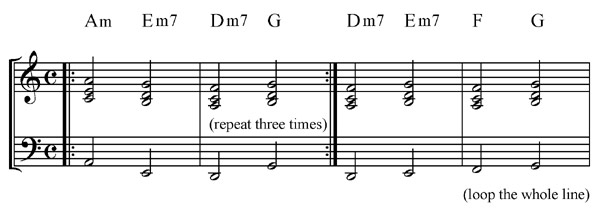
The audio plays the chords straight (with the ‘repeat three times’), then with syncopated right hand chords and straight bass, then with the bass joining in the syncopation. Sing or clap along with the syncopated part to get the rhythm.
The right hand is still playing just A minor, G and F triads. Look at the shape of them – they are all first inversion P M P M M P triads (triangle symbol). Exactly half of them are mediant substitution seventh chords.
This riff goes well with the previous riff, and would work as a backing for a solo or vocal.
Create your own ‘mixed’ type riff
Revisit this Module Six riff and see how much mediant substitution (dropping the bass a third) you think it needs.
Here are the chords and the full riff audio.
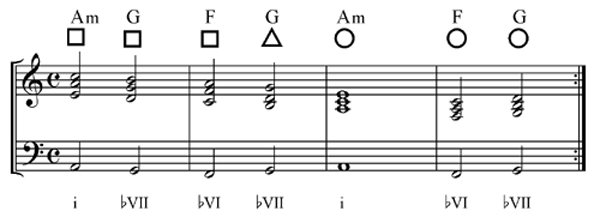
Revisit the relevant part of Module Six to build up the rhythmic/broken chord texture if necessary.
Here are the chords with the bass line dropped a third (all mediant substitution).
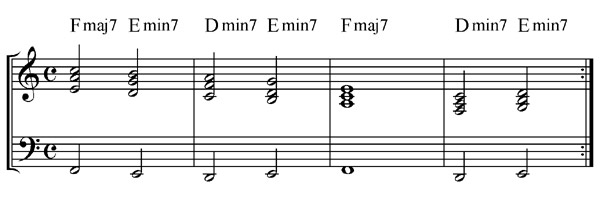
Here’s how to proceed.
- Play the Module Six riff right hand texture over the new bass line to hear what it sounds like.
- Play the original again.
- Decide where you would drop the bass to get the mediant substitution seventh chords and where you would leave it as it is. Remember that you can repeat the riff, so you can make more than one choice.
- Write down the chord sequence of the mix you decide is best.
- Try joining the result up with the two riffs in this module to make an extended riff.
Every time you apply the mediant substitution process to a set of chords you deepen your understanding of how the harmony of popular music works. More and more chords will seem to 'just appear' under your fingertips.
|
OUT NOW! |
THE MUSICARTA BEAT & RHYTHM WORKBOOK At last! An effective approach to keyboard rhythm & syncopation skills. Learn more! |
ONLY $24.95! |
MODES |
The MusicartaA methodical approach to keyboard syncopation for
|
PUBLICATIONS
exciting keyboard
creativity courses
CHORDS 101
WORKBOOK

~HANON~
video course

Musicarta
Patreon
PENTATONICS
WORKBOOK
video course

Creative Keyboard
video course

BEAT AND RHYTHM
WORKBOOK

- Volume 1 -

12-BAR PIANO
STYLES WORKBOOK

MUSICARTA MODES
WORKBOOK

PIANO STYLE

CANON PROJECT
video course

VARIATIONS
video course


- Piano Solo -
video course

- Piano Solo -


YouTube playlists





 THE LOGO
THE LOGO
